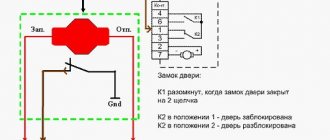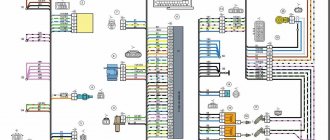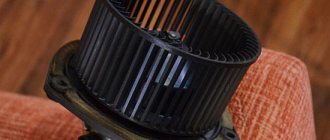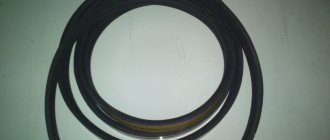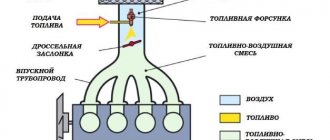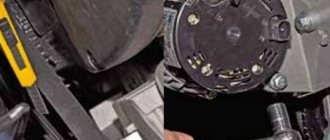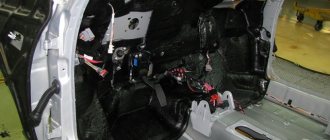The ECU has become an integral part of a modern car. The domestic Lada Granta model is equipped with such a device, labeled as “M74 CAN”. The module allows you to automate most processes occurring in nodes and systems. The control function of the ECU is achieved due to the presence in the units of various types of sensors that send signals to the “brain center” of the car.
Over the long period of operation of the Lada Grant, an annoying drawback of the ECU was identified - its insufficient sealing and sometimes the ECU pinout is required. Penetration of moisture inside the unit casing provokes burnout of the microcircuit, which subsequently ends in the need to replace the device.
The ECU is located at the bottom of the front panel (under the glove compartment) opposite the front passenger seat and is hidden from view by layers of sound-insulating material and upholstery on the inner surface of the bottom. Now you know where the ECU is located, all that remains is to find out other details.
Grant timing belt
“Itelma 11186-1411020-222”: from stock firmware to chip tuning?
The dilemma associated with the rationality of performing firmware on the “native” software in the ECU excites the minds of many owners.
Here it is worth highlighting the optimized dynamic firmware version for the 1.6-liter 8-valve Lada Granta, which has the “M74” module and meets the toxicity standard according to “E2”.
What preferences does this firmware have? After performing a certain list of manipulations and returning the ECU to its rightful place, optimization of the parameters of fuel supply and ignition distribution is observed. Also, one of the purposes of the firmware is to ensure that the settings of the throttle assembly are adjusted.
Chip tuning allows you to physically disable the 2nd DC (“lambda”) in combination with the catalyst. The implementation of such firmware leads to an increase in the dynamic capabilities of LADA Granta.
The role of the stock firmware is to form the parameters characteristic of normal driving conditions. Let us remind you that the “native” version of the firmware is included in the warranty package. Self-correction of the firmware version without any alternative leads to the cancellation of warranty coverage.
Today, so-called commercial versions of firmware software are available to the mass consumer, including the following:
Lada Granta repair and operation department (VAZ 2190)
(ECU, Lada Granta controller) is connected by electrical wires to all sensors of the system. The ECU receives information from the sensors, the unit performs calculations in accordance with the parameters and control algorithm stored in the memory of the programmable read-only memory (PROM), and controls the system actuators. The program version recorded in the PROM memory is indicated by the number assigned to this modification of the ECU (controller, computer).
The control unit detects a fault, identifies and stores its code, even if the fault is unstable and disappears (the fault does not appear constantly).
After repair, the fault code stored in the control unit's memory must be erased.
The Lada Granta control unit (controller) supplies 5 and 12 V DC to various sensors and switches of the control system. Since the electrical resistance of the power circuits is high, the test lamp connected to the system terminals does not light up. To determine the supply voltage at the ECU terminals, use a voltmeter with high impedance (10 MΩ). The electronic unit is installed in the cabin at the feet of the front passenger.
Re-flashing process
The M 74 CAN module in the Lada Granta is located in front, opposite the passenger seat. To flash the firmware it must be removed. First, you should bend the trim and sound insulation of the interior and unscrew the 3 bolts. Now you need to disconnect the wires. This can be done by squeezing the clamp of the bracket; the connector will easily come out of its place. Of course, this work should be done with the negative terminal disconnected. The ECU has been removed, you can proceed to programming it.
In addition to the available adapter, program with an additional module and firmware, you will need a 12 V power supply, or even better, a battery. Next comes the most important part of the work. You need to connect the connectors of the adapter and the ECU with wires. You will need any 2 switches. With their help, + 12 V will be supplied to the required contacts when necessary. The connection is made in the following order:
- connector 1 (large);
- J1 - switch 1, switchable voltage (K15);
- B2 - switch 2, programming permission (12V);
- A4 - switch 2, programming permission (12V);
- E2 -CAN-L;
- E3 -CAN-H;
- K1 - 510 Ohm jumper on E3;
- connector 2 (small);
- G2;G3;G4 — mass;
- H1;H2 - non-switchable voltage (K30);
- F2 - switchable voltage (K15);
- D2 - K-Line.
The letters and number on the left side of this column are contacts on the ECU connectors. In brackets are the adapter contacts. Once everything is connected, check again carefully. If everything is fine, you can proceed to uploading the firmware. Turn on the program. Make the necessary settings. After this, press switch 2 and start the reading program.
This is necessary in order to save the factory firmware just in case. As soon as the process is finished, click “Record”, select the firmware and upload it. The process lasts 5-8 minutes, after which a message about successful loading is displayed.
https://youtube.com/watch?v=gJfpAd-R7js
What to expect from ECU tuning
Reflashing allows you to correct errors and optimize vehicle performance
Companies offering chip tuning services develop and offer various software that allows you to optimize the basic performance of cars.
This process allows you to correct all sorts of errors, create a backup copy of the initial settings, study and adjust characteristics, as well as make changes and test new firmware of electronic components.
If you need to return to default settings, this is done almost instantly. But those who have already reflashed Granta will never return to the standard factory settings. After flashing you can get:
- reduction in fuel consumption by 5%;
- high speed characteristics;
- 10% increase in power;
- smooth operation of the automatic transmission;
- improved traction.
And that's not all. In this case, not a single intervention is made in the mechanics. This is one of the cheapest ways to make Granta better. There is one caveat. If the car is currently under warranty, after flashing the ECU, the warranty is invalid.
Modern chip tuning specialists offer 3 different firmware options for the Lada Granta controller. Of course, there are more of them, but not all are ideal. Particularly popular systems are “Paulus”, “Icebreaker” and “Adakt”. They are the most tested and tested.
Some experts suggest installing one of the control programs, or all three. Sometimes they offer to try each one and then choose the one you like best. The actual firmware installation takes about 30 minutes on average.
Removing the controller (ECU) Lada Granta
Tools:
- Ratchet wrench
- Extension
- 10 mm head
- Medium Phillips screwdriver
Note:
Remove the controller for replacement or when performing vehicle repair operations that may cause damage to the electronic components of the controller (for example, when drying the vehicle in a drying chamber after painting, etc.).
1. Before removing the controller, disconnect the wire terminal from the negative terminal of the battery.
Main controlled parameters.
To ensure the functioning of vehicle components and assemblies, the control unit collects and processes signals from the following sensors:
- Temperatures - engine, fluid in the cooling system, environment;
- Air flow and fuel supply;
- Idle mode;
- Vehicle position on the lane, anti-wear, ABS and other safety systems;
- Speed, engine speed, position of the crankshaft and camshafts;
- Throttle valve tilt and gas pedal position;
- Fluid pressure in the brake system;
- Interior climate and air conditioning sensors;
- Power steering or electric power steering;
- Voltage in the vehicle's on-board network.
The set of signals processed depends on the model and modification of the car (for example, for SUVs with air suspension, monitoring of its condition is required). In the most prestigious brands and configurations, the number of interrogated sensors is several dozen.
Devices controlled by the ECU:
- throttle valve and air supply system elements (for example, turbochargers);
- fuel supply system devices (injectors, nozzles, when fuel injection is carried out under electronic control);
- valve timing control system;
- electronic distributors of the ignition system;
- cooling system fan;
- solenoids and valves for gear shifting in automatic and robotic transmissions;
- differential locking clutches;
- stove, air conditioner and other climate control devices;
- head light, interior lighting;
- window regulators;
- elements of electrical equipment of a car.
Like the number of sensors, the set of controlled actuators depends on the make, model, configuration, and options of the vehicle. In business or premium class cars, the number of control commands can exceed the set typical for budget cars by an order of magnitude.
Example of a device diagram:
Key performance indicators
A complete engine performance analysis will be checked.
- Battery voltage level (UACC). To carry out the test, it is necessary to turn on all the most powerful sources of energy consumption. If the voltage reading on the diagnostic screen is less than it should be, you will have to check all electrical circuits separately. Normal values are from 14 to 14.5 V.
- Mass air flow (AIR). The indicator is determined by the mass air flow sensor. Without diagnostic equipment, checking air flow is impossible. To obtain the value, you need to press the gas pedal until the speed is 5000. If the sensor is working, the indicator rises to a level of 200-250 kg/h.
- Injection pulse duration (INJ). This is the time fuel is injected into the cylinder while each injector is open. Indicators that exceed the norm indicate that the injectors are most likely clogged and clogged. To fix the problem, the parts should be washed. The reasons may also be a clogged fuel filter or a pump failure. To accurately diagnose the problem, press the gas pedal. Normally, the indicators should be from 3 to 5 in a calm, idle state and from 15 to 20 when gasping.
- Oxygen indicator before the catalyst (ALAM1). It should not exceed 0.7 V and, reaching this figure, go back down. This indicates that the feedback is working properly.
- Number of idle speed control (FSM) steps. In other words, the idle speed control sensor. It is a stepper electric motor with a cone-shaped plug attached to the shaft. When the engine is idling, this figure is 40-60 steps, when accelerating - from 150 to 180 steps.
- Estimated fuel consumption (QT). For a complete diagnosis, check the pressure in the fuel rail and the voltage in the spark plugs. It wouldn't hurt to check the compression on the cylinders and find out the CO. However, for all these measurements, in addition to the diagnostic connector and standard equipment, you will need another, expensive device and the connection of experienced professionals. Therefore, here you will have to limit yourself to one indicator: from 0.6 to 0.9 l/hour at idle.
Return
What types of ECUs are available to Granta and what is the principle of their operation?
Sometimes the Lada Granta model is identified with an exclusive car. Why is she given such status? It's simple. "Lada" has a unique control unit, which is called "Itelma 11186-1411020-22" and cannot be combined with previous modifications of "VAZ". The primary difference of this module is the integrated “CAN bus”. Previously produced models used the “K-channel” to ensure the transmission of pulses. If you set out to experiment and replace the Itelma with a similar device with functionality in the K-channel, then in the end the devices on the panel will certainly “fall asleep”.
Where is the ECU located and what is its operating principle? It is based on a special type of algorithm, the formation of which occurs on the basis of software pre-integrated into memory. This allows the module to process signals from all sensors present in the ECM in real time.
The process associated with processing streaming information allows the control unit to subsequently carry out corrective actions regarding the functioning of such systems:
- nozzles;
- ignition system coils;
- throttle mechanism;
- sensor-regulator of idle modes, etc.
To be able to identify the type of device in a LADA Granta car and the firmware version of its software, a special marking code is applied to the body, which allows for the correct selection of an analogue if there is a need for replacement, and in some cases pinout of the ECU is required.
Features of the Scanmatic-2 scanning kit
The designated set can be easily found in the retail chain. It fits such a thing as the diagnostic connector on a Lada Granta car, but will require the use of a laptop. The Scanmatik-2 package initially includes a scanning program. The cost of such a device (set), according to the official website, is 13,700 rubles. In terms of applicability to domestic cars, this is the best option for scanning, as evidenced by many reviews from diagnosticians.
To diagnose it yourself, first of all we boot up the laptop and activate the required program. Using a “USB” format cable, we connect the computer with the vehicle’s diagnostic socket. In the dispatch menu of Windows devices, we find the appearance of a “fresh” “COM” port, which we “register” in the settings. We insert a cord with an “OBD-2” connector into the diagnostic connector, which is connected with a “USB” cable using the adapter included in the delivery kit. We control the glow of the green lamp, which is equipped with the OBD diagnostic connector, which indicates the correct connection. After launching the special program, activate the “Engine” tab and click on the “Auto-detection” symbol. This allows the program to identify the on-board car computer on the Lada Granta.
If identification is not carried out automatically, then it is possible to manually select the name of the modification (in our version, “VAZ”) from the versions present in the software registry. A menu will appear on the display allowing you to select the ECU. There are cases when the program fails to determine the brand of the on-board controller, for example, when the software was previously “reflashed”.
After communication has been established between the ECU and the diagnostic tool, a list containing diagnostic modes is displayed on the screen. We enter the working window and get the opportunity to view the list of parameters, as well as adjust their settings. This point helps not only to find the fault, but also to improve the configuration of any system. To implement this action, you will need to enter the section called “Settings”. The “View” menu allows you to adjust the settings of the “Blutooth” function in case of using a wireless switching method.
The user of a Lada Granta car can create a set of parameters, which can subsequently be extracted from a list of values pre-present in the program. For example, using this method you can create a specific set that allows you to check the idle speed of the engine, and then save the data and use it an unlimited number of times in the future.
Upon completion of the diagnostic process, we return to the program menu for selecting the ECU and deactivate the ignition.
Location of the Lada Granta ECU
We can talk for a long time about how important the correct operation of the electronic control unit (ECU) is. The functioning of the heart of your car depends on it: from increased fuel consumption to the fact that the car may stall as a result of incorrect operation of the controller.
The ECU is located under the glove compartment under the passenger's feet and hidden under the upholstery. The upholstery is attached to the body on the right with a self-tapping screw.
I would like to immediately convey a special greeting to the designer of AvtoVAZ, who came up with this arrangement of this block. In my opinion, I can't think of a worse place. See for yourself.
- If your interior heater (radiator) leaks, the antifreeze will go straight to the control unit, causing almost 100% failure. Even though the Lada Granta is initially equipped with a good quality imported Visteon radiator.
- As you correctly noted, water can get in from under the hood. The rubber plugs on the Lada Granta are not of very good quality, so when they dry out, water will flow onto the controller. To prevent this from happening, check the condition of the rubber plug.
Water enters the controller through this plug.
There are two ways out of the situation, or rather three.
- Leave everything as it is and hope for chance.
- Place the plug tightly onto the sealant.
- The most labor-intensive is moving the controller higher, closer to the passenger airbag, with the contacts facing down.
Can be attached to the air duct
Video about how the ECU is flooded on a Lada Granta
The hose that receives water goes directly into the car interior. In my photos there is an alarm bell, so it's hard to see.
The ECU has become an integral part of a modern car. The domestic Lada Granta model is equipped with such a device, labeled as “M74 CAN”. The module allows you to automate most processes occurring in nodes and systems. The control function of the ECU is achieved due to the presence in the units of various types of sensors that send signals to the “brain center” of the car.
Over the long period of operation of the Lada Grant, an annoying drawback of the ECU was identified - its insufficient sealing and sometimes the ECU pinout is required. Penetration of moisture inside the unit casing provokes burnout of the microcircuit, which subsequently ends in the need to replace the device.
The ECU is located at the bottom of the front panel (under the glove compartment) opposite the front passenger seat and is hidden from view by layers of sound-insulating material and upholstery on the inner surface of the bottom. Now you know where the ECU is located, all that remains is to find out other details.
Electric power steering
When the EPS diagnostic light comes on or the electric power steering switches on/off after a certain period of time, you first need to check the EPS using the diagnostic connector. Open Diag (application) together with an OBD-2 adapter or scanners will help here:
The diagnostic process is designed to indicate where errors are located and decipher them for further repair based on the type of malfunction. In addition, it is quite possible to perform the check without a scanner:
- There is an 8-pin connector (black) under the ignition switch under the steering wheel. It is necessary to dismantle the casing at the steering column (unscrew the fastening screws from below).
- Insert the paper clip, closing the two contacts.
- Turn on the ignition and observe the warning lamp.
- The first signal will be the continuous burning of the lamp (“1”).
- It is necessary to count subsequent short signals, that is, if there are 3 short ones, then “3”.
- In our case, the code “13” should be formed.
How to dismantle the ECU?
It’s easy to remove the controller with your own hands:
- Operations are performed to provide access to the device, for example, partial dismantling of the center console or disassembling the instrument panel.
- The negative terminal of the battery must be removed to avoid emergency situations with the connected unit.
- The fixing latches or clamps on the sensors, actuators and power cables are removed.
- The connectors are disconnected.
- The fixing bolts are unscrewed and the ECU is removed.
The decision to repair or replace is made based on diagnostics. In any case, failure entails significant costs - the cost of units for domestic cars is in the range of 10-20 thousand rubles, for foreign cars 14-50 thousand rubles. (depending on the class of car). Repairs will cost 40 - 50% of the indicated amounts.
Video with instructions for replacing the ECU unit on VAZ models.
Instructions for replacing the block
The need to remove the control unit may arise for various reasons. For example, the problem may be the failure of the control device or the need to reflash it. It should be taken into account that flashing the ECU is a very important and responsible procedure that not every car owner can handle. Incorrect actions in the process of performing this task can lead to the fact that the unit becomes completely inoperable; accordingly, such an undertaking can cost the owner of the car dearly.
So, to dismantle the unit you will need to partially remove the center console.
To complete this task yourself, follow these steps:
- First of all, you need to unscrew the bolts that secure the handbrake trim.
- Remove the cover from the gearbox control lever, and the facing panel must be dismantled.
- Next to the pedals, it is also necessary to unscrew the fixing bolts and dismantle the plastic lining.
- Lift the plug on the center console and remove it. Having done this, you will be able to see the connector for connecting the control unit via USB output.
- The fixing bolts of the fuse block must also be unscrewed, after which the connector can be removed from the installation site. The side bolts securing the console also need to be unscrewed.
- After completing these steps, you can turn off the cigarette lighter and raise the center console slightly. The ECU itself is located on its right side. In order to dismantle the control device, you will need to unscrew its fixing bolts, and then disconnect the block with the power wires. Do this carefully so as not to damage the connectors, otherwise problems may arise during further installation.
- After completing all these steps, the device can be removed. It is repaired, re-flashed or replaced, then reassembled in the reverse order. As you can see, in general the removal procedure is quite simple.
How to check mass with a multimeter
Disconnect the negative terminal of the battery
We take a multimeter and switch it to resistance measurement mode up to 200 Ohms. We check the resistance of the probes themselves by connecting them together
The resistance of the probes themselves is 2.1 Ohms.
Now we connect one probe to the engine. At least here
And the second probe is to the engine control unit, which, in turn, is screwed to the body
We look at the multimeter readings. So what do we see? But we usually see the same 2.1 Ohm
What happens - the mass resistance of the engine - the body has practically no resistance? Is everything perfect? Is the engine and body weight OK? What is the problem then? Is the starter defective or are otherworldly forces overcoming you?
The whole thing is much simpler. What is a mass chain in the understanding of an ordinary person? This is just a piece of wire that connects the engine to the body. Just a piece of wire! If we connect ohmmeter probes to the ends of this wire, then we will find out its resistance. It will be minimal - it’s just a piece of copper wire. Right? Right.
If we connect the voltmeter probes to the ends of this wire, we will see zero voltage. After all, where will the potential difference come from on a single piece of wire? Right? Right.
Now let's connect our voltmeter to this ground wire on the car. That is, as when measuring resistance, one probe is to the engine, and the second to the body. They are connected by this piece of wire. Right? Right.
We switch the multimeter to the mode for measuring constant voltage up to 2 Volts. We start the engine and look at the device display.
Oops. And we have tension!
How can this be - we are connected to the ends of one wire, and we have voltage.
So I showed off my artistic creativity and painted a picture of what was happening
These values on the multimeter display are nothing more than the voltage drop on our ground wire! Even though it looks great and has minimal resistance, it still drops voltage. Moreover, the greater the consumer current in the circuit, the greater the voltage drop on this wire will be, which can reach several volts!
This is the situation. And the mass of the engine and body is not as good as it seemed at first, and problems from it are inevitable.
How to come out of such a situation as a winner?
First, it is necessary to periodically service this section of the chain.
Unscrew the mass on the body
Do the same with the mass on the engine.
But this doesn't always help. The fact is that this chain still has weak points - crimps.
Crimping lugs, crimping on battery terminal
All this oxidizes over time and cannot fully perform its function.
It is necessary to either re-crimp these connections, or it is better to change these wires sometimes.
Here is a video on the topic of engine mass - body
Well, ideally you can lay additional ground wires: Generator - body
General requirements for obd
The no OBD regulations establish minimum basic requirements by law. However, there are only slight differences between European and American requirements.
Basic requirements for OBD systems:
- catalyst control;
- particulate filter control;
- control of lambda probes;
- misfire detection;
- recognition of incomplete combustion;
- fuel system control;
- control of the additional air intake system;
- control of the exhaust gas recirculation system;
- control of the fuel tank ventilation system;
- cooling system control;
- valve control system control;
- registration of working conditions;
- standardized management of malfunction indicators (MIL);
- standardized diagnostic interface;
- message about the system’s readiness for testing (readiness code);
- protection against interference and manipulation of the ECU;
- control of special automatic transmission functions (related to exhaust gas).
To meet these requirements, a variety of sensors are needed to monitor the engine electronics, exhaust tract and exhaust pattern. Constant self-diagnosis and signal plausibility checks guarantee comprehensive control. Malfunctions that occur after standardization are recorded in a memory device.
OBD systems, through sensors, must continuously detect, analyze and record at least the following engine parameters and operating conditions:
- engine temperature;
- mixture adaptation;
- engine load;
- fuel pressure;
- engine speed;
- movement speed;
- fault information;
- car mileage;
- fault codes;
- pressure in the inlet pipe;
- supply voltage;
- state and function of the lambda control circuit.
Additionally, other important quantities are determined and analyzed - oil temperature, ignition timing, air flow, throttle position, valve timing, air conditioning function, crankcase ventilation, exhaust temperature and automatic transmission function. However, there are some differences between the definition of values in EOBD and CARB OBD II.
Table. Comparison of CARB OBD and EOBD requirements
Where is the ECU located?
In the cabin, the unit can be found under the panel. In models from AvtoVAZ it is located near the heater radiator. On business-level foreign cars, the ECU can be found under the rear seat. Some manufacturers try to install the controller in the trunk. Placing the ECU under the hood is not the best solution.
After all, the block is affected by rain, snow and other factors. Often in the engine compartment this device can be found near the battery or under the safety block. It’s not difficult to find – even an ordinary car owner without special skills can find it. You just need to disassemble the dashboard a little or find the unit under the hood. Externally, it is a box from which two wire harnesses extend. But you shouldn’t repair the ECU yourself without special knowledge. It is better to entrust this work to professionals.
Decoding codes after diagnostics with a scanner
As stated above, if the measured characteristics do not differ from the standard ones by more than 20%, then everything is in order with the car. What are the standard parameters?
| Parameter | Meaning |
| UACC | Shows battery voltage. To understand whether there is an error in this case, it is necessary to activate all devices that consume the most voltage. Allowable voltage is from 13.9 to 14.5V. If it is less, then it is necessary to check individual circuits of the network. |
| THR | Throttle position parameter. As a rule, if it is faulty, the driver will know about it without diagnostics, since the car will move jerkily and the engine power will constantly drop. Press the gas pedal without starting the engine, but turning on the ignition. The TPS readings should gradually increase to 90% (or slightly less). If everything is so, then the sensor is working; if not, it needs to be replaced. |
| FREQ | Crank pulley rotation speed parameter. The rotation speed is up to 840 rpm. If this sensor fails, the operation of the motor will be impossible. |
| AIR | Mass air flow parameter. It should not exceed 12 kg/hour. Start the engine and press the gas pedal so that the number of revolutions increases to 5 thousand per minute. In this case, the parameter should increase to approximately 250 kg/hour. Naturally, if the device is working properly, then the indicator will be like this. |
| UOZ | Represents the ignition timing angle. It should change in the range from 6 to 15 degrees. |
| INJ | This parameter bk represents the duration of the injection pulse (the time required to open each injector so that gasoline enters the cylinder). Ideally, this parameter should be between 3 and 5 milliseconds when driving at neutral speed. If the readings obtained during diagnostics are much higher, then, most likely, the injectors are already clogged and need to be cleaned. Or this indicates low gasoline pressure as a result of a clogged gasoline filter or pump. Press down the gas pedal sharply. The injection time should increase to 20 ms. Ideally, accurate diagnosis of injectors is only possible using a test bench. |
| FSM | Idle speed sensor performance indicator. Ideally, this parameter should not exceed 50-60. If you press the gas pedal sharply, it can increase to 160-180. |
| ALAM 1 | Indicates the voltage level recorded on the oxygen level monitoring device. When the car engine is warmed up, this indicator should increase from 0.007 to 0.7 V. If this indicator differs, then something is wrong with the circuit. |
| LUMS_W | This coefficient indicates the rotation of the crank pulley. Ideally, it should vary around 4 revolutions per second. If it is slightly larger, then this already indicates a misfire in the engine cylinders. This means that you should pay attention to checking the spark plugs (whether they are working, filled or not), as well as the condition of the high-voltage wires. |
| QT | Gasoline consumption coefficient. With the engine running and idling, it should not exceed 0.9 liters per hour. |
Engine control modules [ edit | edit code]
">Company controllers
- Bosch M1.5.4 (55 Pin) (1.45/1.5l., 8kl.) (Russia-83) Simultaneous injection.
- Bosch M1.5.4N (55 Pin) (1.5 l., 16 kl.) (Euro-2) In pairs - parallel injection / Phased injection.
- Bosch MP7.0HFM (55 Pin) (1.5/1.7l.,8/16kl.) (Euro-2/3) In pairs - parallel injection./Phased injection.
- Bosch M7.9.7 (81 Pin) (1.5/1.7l.,8/16kl.) (2003 – 2007) (Euro-2/3) In pairs – parallel injection./Phased injection.
- Bosch M7.9.7+ (81 Pin) (1.5/1.7l.,8/16kl.) (2005 – 2011) (Euro-3) Phased injection.
- Bosch ME7.9.7 (Euro-3) Phased injection.
- Bosch ME17.9.7 (Euro-3) Phased injection.
">Controllers
- Delphi MT20 (Euro 3)
- Delphi MT80 (Euro 3/4/5/6)
- Delphi MT92 (Euro 3/4/4/6) – Gasoline Direct injection (GDi).
- Delphi AC Delco E39/E39A (Euro 2)
- Delphi AC Delco E73
- Delphi AC Delco E78
- Delphi AC Delco E83
- Delphi MR140
">Controllers
- GM EFI-4 (24/32/32 Pin) (USA-83) – Single injection.
- GM ISFI-2S (24/32/32 Pin) (1.5 l. 8/16 cells) (USA-83/Euro-2) – 8 cells. in pairs - parallel injection, 16kl. phased injection
- GM ITMS-6F (Euro-2) – In pairs – parallel injection.
">Controllers
- Simtec 70 (Euro 2) Phased injection.
- Simtec 71 (Euro 3) Phased injection.
- Simtec 75.1 (Euro 4) Phased injection.
- Simtec 75.5 (Euro 4) Phased injection.
- Simtec 76 (Euro 2/3)
- Simtec 81 (Euro 5) Direct injection.
">Controllers
The January xxx and Mxx controllers were produced at two different factories - Itelma (The first element in the firmware designation is the letter “I” in the ECU marking) and Avtel (The first element in the firmware designation is the letter “A”.
- January 4 (24/32/32 Pin) (1.6l., 8kl.) (Russia-83) In pairs - parallel injection. (The label contains the designation of the debug version “Kvant”.)
- January 4.1 (24/32/32 Pin) (1.5l., 8/16kl.) (Russia-83) (1998) Phased injection. (The label contains the designation “Quantum”.)
- January 5.1 (55 Pin) On the label: NPP AVTEL LLC, TU 4573-004-45886863-99, .
- January 5.1.1 (55 Pin) On the label: NPP AVTEL LLC, TU 4573-004-45886863-99, . (1.5 l., 8 cells) (Euro 0) Simultaneous injection.
- January 5.1.2 (55 Pin) On the label: NPP AVTEL LLC
">Controllers
- VS 5.1 1411020-02 (1.45l, 8kl.) (Russia-83) Simultaneous injection.
- VS 5.1 1411020-72 (1.5l, 8kl.) (2003- ) (Russia-83) Simultaneous injection.
- VS 5.1 1411020-62 (1.5l, 8kl.) (2003-) (Euro 2) Pair-parallel injection.
- VS 5.1 1411020-42 (1.5l, 16kl.) (2003-) (Euro 2) Phased injection.
- VS 9.2 (Euro 4) Used diesel engine UAZ 3151 (Hunter).
- T11183 (Euro 2/4) (1.6l, 8kl.)) Pair-parallel injection.
- T11186 (Euro 4) (1.6l, 8kl.)
- T11194 (Euro 3) (1.6l, 16kl.)
- T21067 (Euro 3) (1.6l, 8kl.)
- T21114 (Euro 2/3) (1.6l, 8kl.)
- T21116 (Euro 4) (1.6l, 8kl.)
- T21124 (Euro 2/3) (1.6l, 16kl.)
- T21126 (Euro 3/4) (1.6l, 16kl.)
">Controllers
In the designation of the firmware January 7.2 and Mikas 10 there are the following designations: (I – Itelma) (A – Avtel).
- January 5.1 (55 Pin) (1.5 l., 8/16 cells) (Euro 2) On the label: , TU 4573-004-45886863-99. (1999 -) Simultaneous injection.
- January 5.1.1 (55 Pin) (1.5 l., 8 cells) (Russia-83) Simultaneous injection.
- January 5.1.2 (16 grades) (Russia-83) Simultaneous injection.
- January 5.1.3 (1.5 l., 8 cells) (Euro 2) In pairs - parallel injection.
- I 7.2 (81 Pin) (1.5/1.6l., 8/16kl.) (Euro 2) (2004 – 2007) Pairs - parallel injection. / Phased injection.
- I 7.2M (81 Pin) (1.6l., 8/16kl.) (Euro 2) (2007 – ) Pairs - parallel injection. / Phased injection.
- M10.3 (Euro 2/3).
- M73 (1.4/1.6l., 8/16kl.) (Euro 3) (2007 –) Phased injection, works without a camshaft position sensor (phase sensor).
- M74 (1.6l, 8/16kl.) (Euro 3/4) Phased injection.
- M75 (1.6l, 16kl.) (Euro 4) Phased injection.
A modern car is more than just four wheels and an engine. This is a smartphone on wheels. The operation of all systems of a modern car is controlled by a huge number of different sensors. This information is then analyzed by a special computer and other electronic components. The more expensive the car, the more different electronic options it has. All this “orchestra” is controlled by one small box - this is the ECU. What it is? This is an electronic control unit. We'll talk about it today.
Grant diagnostic connector: type; scheme
The Grant diagnostic connector is a 16-pin ODB-II type. The contact diagram itself (freely available) consists of the standard grounding of the Lada Granta body (4), as well as the standard signal grounding (5).
As for dedicated lines for connecting the alarm system, on-board computer: (6 – dedicated CAN line (class – High), J-2284) and diagnostics (7 – K-line diagnostics SO 9141-2 and ISO/DIS 14230-4); (14 – CAN-Low Line, J-2284); (15 – L-line diagnostics ISO 9141-2 and ISO/DIS 14230-4).
Vehicle safety control, and in particular immobilizer data input/output – (14 – Input/Output for VTM-4 and immobilizer control).
Slow diagnostics of reading stream data to determine the general condition of vehicle systems (9 – SCS (Service Check System)). Updating software, making changes to settings in RAM memory (12). As for power, here you need to pay attention to pin number 16 (Power from battery (12V)).
Having information regarding the type and circuit of contacts, the owner of a Lada Granta has the ability to connect various devices, among which can be an on-board computer or a scanner.
Photo from under the glove compartment
Photo of the connector from the driver's door
Photo of the connector from a medium distance
Close-up photo of the connector In my Lada Granta, the diagnostic connector is located to the left of the glove compartment under the instrument panel. The reference point for the search is the passenger foot air nozzle. If you draw a parallel from the top point into the panel, you will see a diagnostic connector.
In my opinion, not a very good location. Let me explain why. If you want to use this connector to permanently connect the ELM327 (diagnostic adapter), then, depending on the model, it will stick out a little, so moisture from the passenger’s feet may get inside it. Also, strong passengers may accidentally try to tear it off or press it with their feet, which can cause damage.
A passenger may accidentally trip the diagnostic connector with their foot.
https://www.youtube.com/watch?v=UJvWbs2QTys
But, it seems to me, the designers of AvtoVAZ decided to save on wires and not lead the diagnostic connector block to a more convenient place. And they didn’t have a goal to make this connector for permanent connection. Although it is to this connector that on-board computers, such as Multitronics VC731, are connected.
Photo from under the glove compartment Photo of the connector from the driver's door Photo of the connector from the middle distance Photo of the connector close up
In my Lada Granta, the diagnostic connector is located to the left of the glove compartment under the instrument panel. The reference point for the search is the passenger foot air nozzle. If you draw a parallel from the top point into the panel, you will see a diagnostic connector.
In my opinion, not a very good location. Let me explain why.
If you want to use this connector to permanently connect the ELM327 (diagnostic adapter), then, depending on the model, it will stick out a little, so moisture from the passenger’s feet may get inside it. Also, strong passengers may accidentally try to tear it off or press it with their feet, which can cause damage.
But, it seems to me, the designers of AvtoVAZ decided to save on wires and not lead the diagnostic connector block to a more convenient place. And they didn’t have a goal to make this connector for permanent connection. Although it is to this connector that on-board computers, such as Multitronics VC731, are connected.
- Directly to destination. To diagnose a car using an adapter that is connected to a computer or phone, or to a special diagnostic device.
- For the purpose of having fun. Connect the adapter and install the Torque program on your phone, connect to it using a Bluetooth connection, and you can view the data online. And if you have a phone with GPS, then you can measure acceleration to 100 km/h, time to cover a section, etc. Diagnostic connector with connected adapter ELM327
- View engine temperature. Since the first versions of the car did not have an engine temperature indication on the instrument panel, many owners used a diagnostic connector to connect on-board computers, which show many parameters, including engine temperature. And since most Grant owners complain about the low operating temperature of the engine, on-board computers are a very popular solution to this problem.
11.04.2021
- Lada Granta diagnostic connector – the ability to quickly exchange data between vehicle devices and diagnostic equipment.
- It is worth noting the speed of operation and the ability to connect additional equipment, which the owner of the Lada Grata lacks.
With each maintenance, the car receives updates to the preset parameters in the RAM memory. A special advantage is the ability to read stream data from vehicle devices, which in turn simplifies the process of identifying a breakdown and its subsequent elimination.
- As mentioned above, the Lada Granta diagnostic connector provides the opportunity to expand the functions of the car. Among these are:
- • connection of the Multitronics VC731 mini-on-board computer;
- This step allows the owner to monitor the engine flow temperature, since the car manufacturer does not provide this option.
Also among the additional features there is an option to read the error code, as well as the ability to control the “fan” speed. In the software preinstalled by the manufacturer, the maximum speed level is achieved at a temperature of 100 - 110 degrees.
• Connecting the OBD2 adapter -> Bluetooth ELM 327;
The device is quite functional and is also compatible with both PC and Android smartphone. To view streaming data from car devices, you need to install the torque application on your smartphone (completely free).
- By connecting the OBD2 -> Bluetooth ELM 327 adapter with a smartphone, you can view the following parameters of the Lada Granta:
- • revs; • speed; • coolant; • accel; • throttle;
- • vacuum.
- If we are talking about connecting the ELM327 adapter to the diagnostic connector, then it is possible to read such a parameter as “Cylinder misfire counter,” as well as directly determine the cylinder number itself.
Diagnostic connector for Lada Granta
The diagnostic connector of the Lada Granta car is designed according to the OBD-2 standard. On the Lada Grant, the diagnostic connector allows you to read almost all the information about the composition of the mixture and other data stored in the car controller.
This is the operating mode of the fuel correction, the temperature of the coolant and intake air, and other data.
Error code: Diagnostic equipment for Renault Kangoo cars at the best prices in Moscow with delivery
The connector has 16 contacts and is located in the passenger compartment, to the left of the glove box, at the passenger’s feet, next to the ventilation deflector.
The arrow in the photo indicates the location of the diagnostic connector. It’s not that difficult to remove and install the Diagnostic Link Connector yourself.
To remove the ECU yourself, disconnect the negative cable of the on-board battery and remove the screw securing the floor covering.
Next, you need to peel back the upholstery and soundproofing coating to directly see the block itself, secured with 3 nuts.
For self-diagnosis of Granta, a regular K-Line adapter is not enough. The ECU installed here is of a different design than on other VAZs; it requires a special adapter. At the moment, it is popular to use equipment such as the ELM-327 diagnostic adapter and various paid and free software for it (for example, Scan Master, Torque).
Photos of the ELM-327 adapter can be found in reference books or on the Internet. Employees of official servers use the “dealer scanner” DST-14 (diagnostic scanner-tester).
It is unlikely that you will be able to carry out a complete diagnosis yourself, since this is a complex procedure that includes both software and hardware parts, and not just a K-Line connection. Moreover, it requires certain knowledge and experience.
In other words, you need to be able to compare the instrument readings with the real situation.
To do this, you can use a special diagnostic tester (adapter), laptop or smartphone with a special program.
During operation, the diagnostic program will collect and provide the user with information about engine parameters in 1-2 minutes.
The motor has certain characteristics that have permissible deviations. In the data table displayed on the monitor by the diagnostic program, you first need to check for stored errors (indicated as DTC). If there are lines like “error 505”, you need to contact automotive websites and forums or a specialist to decipher them.
Some types of software contain transcripts of a significant list of errors. But the ECU may not produce errors, which does not mean their absence. An acceptable deviation is considered if a particular parameter differs from the basic one by no more than 20%.
If the deviation is greater, you should look for a malfunction. The most important values include UACC (battery voltage), THR (throttle position), crankshaft speed, mass air flow, coolant temperature.
Diagnostic kit "Scanmatik-2"
There is also a Scanmatic-2 diagnostic kit available for free sale, which is quite suitable for the Granta connector circuit (a laptop is required). A diagnostic program is also included in the kit. On the manufacturer’s official website, the price for the set is 13,700 rubles.
Car enthusiasts call this system the best for domestic cars. Suppose you need to do the diagnostics yourself. First, load the laptop and install the desired program. Next, connect the USB cable to the computer. Go to Windows Device Manager.
A new COM port should appear there.
We are waiting for the Scanmatik diagnostic program to start. We set the above-mentioned port in its settings. We connect the adapter to the diagnostic connector using the OBD-2 cord (OBD-2 and USB cords are connected using the included adapter).
Itelma ECU 11186-1411020-22: stock firmware or chip tuning?
The dilemma regarding the need to flash a manufacturer-installed or a new ECU installed by the car owner depends on many factors. Among the main points is the “thoughtfulness” of the car at the time of overtaking or moving in a dense stream of cars.
It is worth noting the optimized dynamic firmware for Lada Granta 1.6L, 8V with an M74 controller and an established E2 toxicity standard. What does the practical implementation of such firmware provide?
As a result of the manipulations carried out and the return of the controller to its rightful place, fuel supply and ignition were significantly optimized. The firmware provides for changing the throttle settings.
Carrying out modern chip tuning on a domestic Lada Granta car provides the opportunity to physically disable the 2nd DC and the catalyst. As a result of such firmware, the dynamic characteristics of the car significantly increase while maintaining a moderate driving style.
The stock firmware of the Lada Granta ECU is designed for ordinary daily use of the car, while the manufacturer's firmware version is included in the warranty package. Unauthorized changes to the firmware version will void the manufacturer's warranty.
At the moment, the end user is provided with commercial firmware for M74 controllers, namely:
• AY_I484GG30 – Lada Granta 1.6l, 8V with pre-installed M74 controller 11186-1411020-22;
• I484GI06-STR – Lada Granta 1.6L, 8V; controller – 11186-1411020-22 and Euro-2 standard;
• AY_484GP12 – with preinstalled M74 controller 11186-1411020-22 and E3/E2 standards.
On-board computer firmware Grants
You can update the software yourself. To do this, you will need a USB-K-Line cable, the firmware itself, a diagram of the Lada Granta ECU, an installation program and a driver for connecting to the adapter.
BC connection diagram for firmware
Schema collection algorithm:
- Take 3 wires.
- Switch T1 is closed as required by the program.
- The computer serves as the power source; just connect to Molex. For the on-board device, you can use the terminal block from the cooler.
- Connect the adapter to the USB port and install the driver. Next, you need to remember the port number you are using.
The firmware process looks like this:
- The program starts and the firmware is selected.
- The desired port is selected.
- Click on the lightning icon, after the “Turn on power” message appears, you need to press any button and start the firmware protocol, this will take several minutes.
To download all the software necessary for flashing the firmware, just go to the official website of the manufacturer of the Lada Granta on-board computer. You can also find all the necessary drivers there.
Basic functions of the device
On-board vehicles for the Lada Granta have high information memory and a small monitor, except for the “State” model, which only has a digital display. This makes it easier for people with poor eyesight and those who are unfamiliar with the nuances of engine operation to monitor all the processes that accompany its stable operation. BC will help the car owner by pointing out the following parameters:
- total travel time;
- detailed fuel consumption at different speeds;
- average speed indicators and excessive fuel consumption;
- remaining fuel in the gas tank;
- speed of start of movement;
- engine temperature;
- malfunctions of components and mechanisms;
- temperature inside and outside the car;
- on-board network voltage;
- crankshaft rotation speed (engine speed).
The on-board computer has a volatile memory and the ability to control the anti-theft system - the Lada Granta immobilizer. The on-board vehicle has a built-in supervisor, a fault indicator, and a “afterburner” function - the ability to reset the memory after starting the engine.
Some on-board drivers can additionally control lighting, stove operation, clock, calendar and alarm clock, and automatic window closers. You can plan your trip route based on the BC readings. It also allows you to use various navigation installation options and can warn you about low fuel levels or exceeding the permissible speed limit.
Most devices allow you to independently diagnose the operation of different car systems. The device can read ECU error codes without using any equipment. The explanation is presented in the accompanying documentation for each device. Such functionality will allow you not only to save on a trip to a specialized center, but also to identify problems, preventing serious malfunctions from occurring.
Using the connector
The main options for using OBD-2 in the Lada Granta include:
- connecting a scanner to check the machine and deal with errors;
- installation/connection of an on-board computer, for example, Multitronics or State.
Connecting an on-board computer to a Lada Granta car will have a useful effect, because in this way it will be possible to:
- monitor the engine temperature;
- receive error codes as soon as they occur;
- forcefully start the cooling fan.
ECU characteristics
We suggest that you familiarize yourself with all the necessary information regarding the operation of the unit below.
Where is the block located?
The engine control unit of a Lada Kalina, Kalina 2 or Granta car is located near the center console of the cabin. To get to it, you only need to remove the panel. As you know, domestic engineers have always been famous for their senseless and “merciless” decisions in terms of assembling cars, so the location of the ECM unit was chosen thoughtlessly. In practice, such a device often fails as a result of moisture getting on it, so many car owners decide to move the unit so that it can stand in a safer place.
ECU location
How does the electronic unit on Grant work?
Before making changes to the car's firmware or performing diagnostics, you need to consider the basic principles. As much as some would like to jump right into making practical changes, you need to understand how the electronic “brain” works.
Any computing system, be it an ECU or a home PC, is a storage device. A home PC contains photos, videos, games, and work software. The computer constantly stores the user’s actions, errors, and data about software failures. All this is hidden among system files hidden from view.
The Lada Granta electronic control unit is also a computer, only the tasks it is designed to solve are more specific. There is also diagnostic information here. It is stored in RAM. This memory stores all the data that comes from various sensors. Information is stored until the block calculates everything it needs for some actions, then the information is erased from memory.
When it comes to diagnostic information, the car owner must be very careful. RAM cannot operate without a power source.
The control unit is a mini computer with specialized functionality
However, in addition to the RAM, there are other memory blocks of the controller. They are completely independent of nutrition. The data stored in them is unchanged. Unchangeable until new firmware is updated. These are PROM and ERPZU.
The first chip stores all the firmware data that was made at the factory. All the original algorithms and operation schemes of all nodes are embedded here. All diagnostic information, calibration data, vehicle weight, engine power and other Grant parameters are also stored here.
The second chip stores anti-theft information. Here are the codes that are on the alarm keys. If the codes do not match, then Grant will not go.
What modes are optimized when chip tuning a Granta power plant?
The plant periodically makes some warranty adjustments at service stations, but not everyone uses this service, and those who undergo warranty maintenance do not always receive it. As a result, owners continue to operate obviously faulty cars, not suspecting that it is enough to correct the electronic algorithm. The point of changing the ECM software is to optimize the operation of the engine and transmission.
Lada Granta modes that require improvement:
- ignition timing;
- injection time value;
- exhaust emission control systems;
- algorithm for determining the octane number of fuel;
- automatic transmission operation.
If desired, the second oxygen sensor can be removed from the circuit to further remove the catalyst.
P O P U L A R N O E:
Sound signaling device for duplicating warning lamps in the vehicle dashboard with a two-tone signal.
The car's audible alarm is designed to duplicate with a two-tone signal all emergency and "turn" warning lamps of the car, as well as signaling when the on-board voltage exceeds 17V.
Alphanumeric marking of inductors and chokes
The data provided below will be useful to radio amateurs when repairing inexpensive radios and radios of Chinese and other models.
Using inexpensive and accessible chips NE555, LM3915 and 7805, you can make a simple engine speed tachometer for a car using 10 LEDs.
The LED tachometer can be used for a car with an on-board voltage of 12V or 24V.
